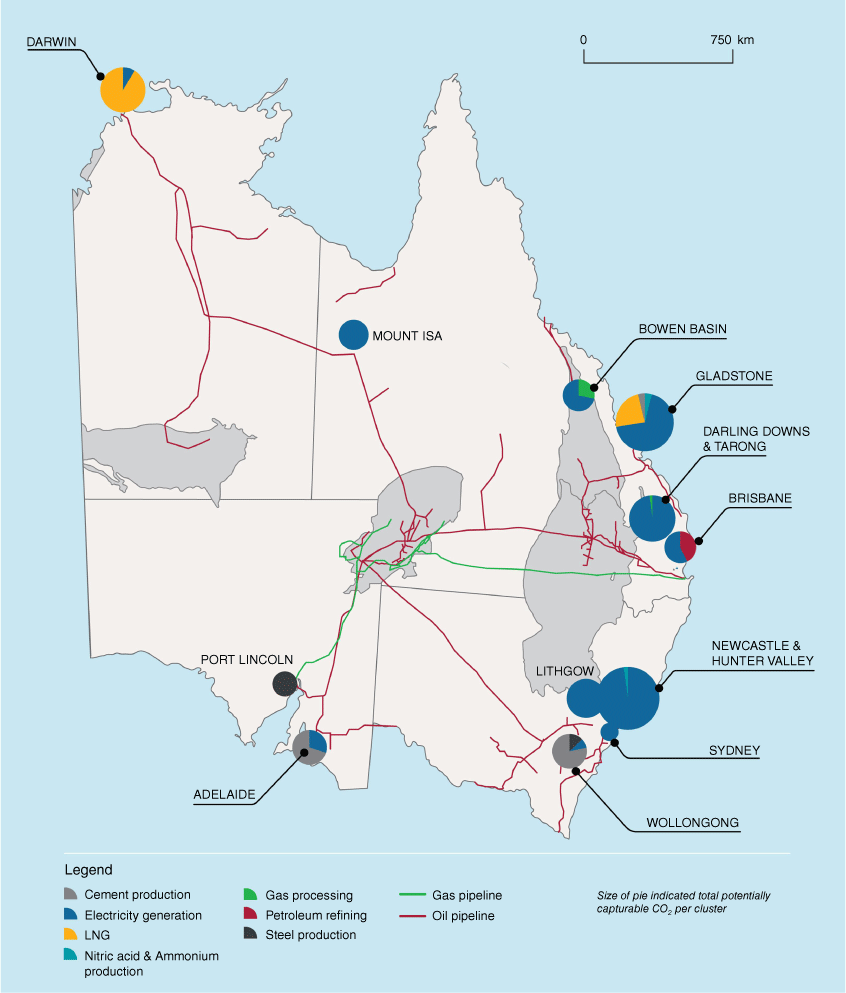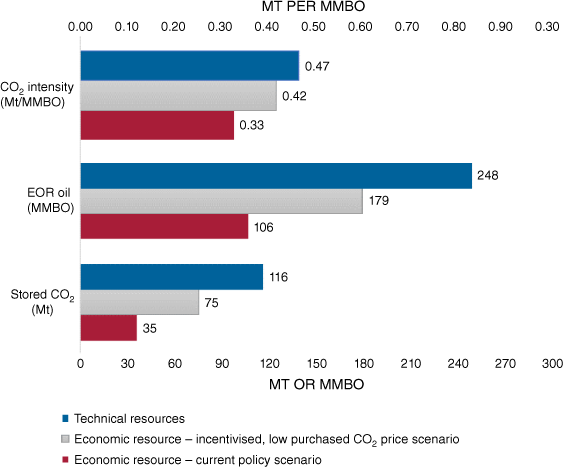Carbon dioxide-enhanced oil recovery in Australia – techno-economic evaluation, carbon dioxide source/sink networks and current policy landscape
David Bason A * , Hadi Nourollah A , Vello Kuuskraa B , Matt Wallace B , Tim Duff C and Matthias Raab AA CO2CRC, Melbourne, Vic., Australia.
B Advanced Resources International, Washington, DC, USA.
C National Energy Resources Australia, Perth, WA, Australia.
The APPEA Journal 63 S341-S346 https://doi.org/10.1071/AJ22113
Accepted: 24 February 2023 Published: 11 May 2023
© 2023 The Author(s) (or their employer(s)). Published by CSIRO Publishing on behalf of APPEA.
Abstract
This paper presents the results of a techno-economics analysis to quantify the potential for storing CO2 and producing lower carbon intensity oil from mature, onshore Australian oil fields located in the Cooper/Eromanga and Surat/Bowen Basins. The work explores the impact of incentivisation, identifies possible sources of CO2 to support CO2-EOR (enhanced oil recovery) deployment, and discusses global CO2-EOR policy. The hypothetical ‘carbon incentive’ assessed in this study resulted in unlocking an additional 40 million metric tons (Mt) of CO2 storage and 73 million barrels (MMBO) of domestic oil production compared to the base case scenario that most closely represent Australia’s current policy and economic settings. Further, the results of this study indicated that, with incentivisation, net-negative carbon dioxide emissions could be achieved by deploying CO2-EOR practices in certain mature oil fields. The study found that there are currently sufficient industrial sources of CO2, particularly from black coal-fired power generation and hard-to-abate industries such as cement and steel production, to support this deployment. An opportunity to explore the co-development of ‘stacked storage’ using both CO2-EOR and concurrent geologic storage of CO2 in adjacent, unconnected reservoirs is proposed. This may significantly reduce development costs compared to stand-alone geologic storage projects, providing more favourable techno-economics, and accelerating the physical connection of CO2 sources and sinks.
Keywords: carbon dioxide, carbon intensity, emissions reduction, energy policy, enhanced oil recovery, net zero, techno-economics, utilisation.
Introduction
In 2020, the Australian Government released its Technology Investment Roadmap: First Low Emissions Technology Statement (Department of Industry, Science, Energy & Resources (DISER) 2020) which identified carbon capture and storage (CCS) as one of five priority technologies in meeting net-zero emissions by 2050. The Roadmap outlines how technology, rather than taxation, is a key principle for Australia’s emissions reductions strategy.
CO2-enhanced oil recovery (EOR), a form of CO2 ‘utilisation’ is the practice of injecting CO2 into an oil-bearing reservoir. This results in the permanent storage of significant volumes of CO2 in the subsurface as well as enabling the CO2 to mix with any oil that it contacts, which can result in increasing the recoverable oil from mature fields. Although CO2-EOR has been implemented successfully for decades, particularly in the United States, it has not gained traction in Australia to date.
In conventional CO2-EOR applications, the aim is to maximise oil production using minimal CO2. However, alternative reservoir management practices focussing on permanently storing higher ratios of CO2 per barrel of oil produced have previously been discussed in literature (Tenthorey et al. 2021). A net-negative emissions position may be achieved when the CO2 stored per barrel of oil produced is greater than the full lifecycle emissions of the combusted oil. Further, additional domestic oil production via CO2-EOR can also reduce the need to pursue higher intensity oil imports and more environmentally challenging settings for new oil reserves.
Bagheri et al. (2022) previously developed an oil field database for Queensland and South Australia, and subsequently quantified technically viable oil recovery and CO2 storage through implementation of CO2-EOR using Advanced Resources International’s (ARI) CO2 Prophet software (Attanasi 2017).
This paper (1) quantifies the potential for storing CO2 and producing lower carbon intensity oil from mature, onshore Australian oil fields located in the Cooper/Eromanga and Surat/Bowen Basins through a techno-economic assessment, (2) quantifies the sensitivity of these parameters to incentivisation, (3) identifies plausible sources of CO2, and (4) addresses global policies for CO2-EOR.
Methodology
Project development parameters
Several development parameters were defined to simulate actual development and operation of CO2-EOR projects in Australia. These development parameters included (1) utilising and recompleting existing wells in the oil field for CO2-EOR operations (minimum of 25% new wells drilled per field) and (2) staggering the development of the CO2-EOR patterns to a maximum of ten, five-spot patterns to be developed per project per year.
Economic cost model
A detailed economic model was developed and benchmarked against cost estimates provided by oil field companies operating within the Cooper/Eromanga and Surat/Bowen Basins (Table 1).
| Cost element | Components |
| CAPEX – wells | Well drilling and completion, recompletion and plugging costs |
| CAPEX – facilities | CO2 recycling and gathering systems |
| CAPEX – pipeline | CO2 delivery pipeline from anchor field to cluster fields |
| OPEX | Water disposal, recycled CO2, purchased CO2, gathering system maintenance, fluid lifting |
| Tax/royalties | Royalty taxes – gross revenue from oil production (QLD/SA 2021) |
Incentivisation
In Australia, Australian Carbon Credit Units (ACCUs) can be claimed for carbon storage, but ACCUs are not currently eligible for CO2-EOR activities. Therefore, a hypothetical ‘carbon incentive’ was applied to quantify the potential impact on CO2 storage and oil recovery. A ‘carbon incentive’ was applied for the purchased CO2 only (not recycled CO2) via the OPEX stream with a 5% price escalation per year for subsequent years.
Industrial sources of CO2
The data underpinning the industrial sources of CO2 is derived from publicly available sources (Clean Energy Regulator 2022a, 2022b) and converted into estimates of theoretically capturable CO2 by applying CO2CRC’s knowledge of applicable capture technologies for the respective industrial processes. For example, it has been assumed that 70% of the emissions (in the form of CO2) from coal power plants could be theoretically captured using known technologies.
Results
Techno-economics
The results of the techno-economic modelling demonstrated that 35 Mt of CO2 can be permanently stored, and 106 million barrels (MMBO) can be produced under modelled economic conditions that most closely represent Australia’s current policy and economic settings (Fig. 1)1. The direct impact of implementing economic CO2-EOR in the identified regions alone would extend the life of the currently producing oil fields, thereby maximising the utilisation of existing project assets, adding significant amounts to the national fuel reserve, while reducing emissions and the cost of new investments.
However, under an ‘incentivised, low purchased CO2 price’2 scenario – potentially achieved through government subsidy or the allocation of theoretical ACCUs – the CO2 storage and additional economic oil recovery increased from 40 to 75 Mt of CO2 and 106 to 179 MMBO, respectively. In some cases, net-negative carbon dioxide emissions can be achieved.
Industrial sources of CO2
In the Australian states and territories included in the study (QLD, SA, NSW, NT), the largest emission sources presented are black coal-fired power stations, with nine facilities generating over 5 Mt of CO2-e Scope 1 emissions per annum; power generation sector emissions are dominated by the states of QLD and NSW.
There are also significant CO2 sources that could be captured from other major industries, including cement and steel. Thus, there is an opportunity to establish CO2 source clusters around the large industrial centres, helping to reduce capital and operating expenditures for transportation to CO2-EOR hubs, in which case over 75% of the potential capturable industrial CO2 source volumes are in the regions of Newcastle/Hunter Valley, Gladstone and Darling Downs/Tarong (Fig. 2).
Potentially capturable CO2 sources by industry, Map (QLD, SA, NSW, NT). Regions with identified annual potentially capturable CO2 sources greater than 0.2 million metric tons are presented and exclude Moomba. Data is primarily sourced from company sustainability reports and Safeguard facility data.

Global CO2-EOR policy
The USA is a global leader in incentivising CO2-EOR. The availability of low-cost, proximal, naturally occurring CO2, tax incentives, and a high oil price in the 1970s and 1980s were major factors that facilitated development of the CO2-EOR industry in the USA (Tanner 1992; Hustad and Austell 2004; National Energy Technology Laboratory/U.S. Department of Energy 2010). In 2008, the 45Q tax credit was first enacted in the United States (Congressional Research Service 2021) and originally provided a US$10/tCO2 credit for stored CO2 via EOR increasing to US$35/tCO2 by 2026 (thereafter linked to inflation). The policy is both technology and fuel-neutral, and therefore aligns with one of the key principles outlined in the King et al. review (Department of Industry, Science, Energy & Resources (DISER) 2020).
Incentivisation of CO2-EOR in the United States contrasts with Canada, where there are four CO2-EOR projects currently in operation. A CCS/CCUS Investment Tax Credit (ITC) was announced in the 2022 Budget after a period of consultation. However, under the current proposals, CO2-EOR is not defined as an eligible use and therefore cannot claim the credit (International CCS Knowledge Centre 2021). In the UK, field allowances indexed to unit technical cost, reduction of headline tax rates and low-interest loans (Durusut and Pershad 2014) have been identified as potential policy levers.
Summary and conclusion
In this study, a CO2-EOR cost model was developed to quantify the potential for storing CO2 and producing lower carbon intensity oil from mature, onshore Australian oil fields located in the Cooper/Eromanga and Surat/Bowen Basins. The modelling demonstrates that 35 Mt of CO2 can be permanently stored, and 106 MMBO can be produced under modelled economic conditions that most closely represent Australia’s current policy and economic settings. Under current Australian policy, CO2-EOR activities are not currently eligible for ACCUs. By applying a hypothetical ‘carbon incentive’, an additional 40 Mt of CO2 can be stored and 73 MMBO could be recovered and therefore added to the national fuel reserve. Alternative national policies have been outlined and highlight the significant incentives available for implementing CO2-EOR in the USA.
Industrial CO2 sources were also identified, highlighting that there is currently a significant supply of CO2 to support the deployment of CO2-EOR. However, the reduction of power generation from coal-fired sources in New South Wales will materially change the geographic balance and magnitude of CO2 sources in Australia. Hence, the pace of this transition will be an influential factor in any future development of CO2 source/sink connecting infrastructure in Australia.
CO2-EOR also has the potential to unlock additional utilisation and large-scale, lower-cost, geological CO2 storage opportunities. By concentrating industrial CO2 sources and developing infrastructure in areas with other sizable CO2 storage reservoirs, CO2-EOR has the potential to accelerate the uptake of CCS in Australia, create new industries and businesses, and assist the country in meeting its net-zero commitments.
As a long-term consideration, EOR with CCS can give Australia a strategic advantage in the global energy market by reducing its dependence on foreign oil and improving its domestic energy production. Furthermore, by reducing its dependence on foreign oil, Australia can better align its energy needs with its national interests and reduce its vulnerability to global energy supply disruptions.
Acknowledgements
The authors acknowledge the (in-kind) support via the provision of subsurface datasets by Santos, Beach Energy and Bridgeport Energy, as well as the contribution of CO2CRC members in developing an understanding of the key challenges and priority actions required to support the deployment of CO2-EOR in Australia.
References
Attanasi ED (2017) Using CO2 Prophet to Estimate Recovery Factors for Carbon Dioxide Enhanced Oil Recovery. In ‘Chapter B of Three Approaches for Estimating Recovery Factors in Carbon Dioxide Enhanced Oil Recovery’. (Ed. MK Verma). pp. B1–B10. Scientific Investigations Report 2017–5062–B. (U.S. Department of the Interior/U.S. Geological Survey) Available at https://doi.org/10.3133/sir20175062BBagheri MB, Wallace M, Kuuskraa V, Nourollah H, Raab M, Duff T (2022) CO2 EOR potential in the Cooper and Surat basins – a cost-effective pathway to reduce CO2 emissions. The APPEA Journal 62, S372–S377.
| CO2 EOR potential in the Cooper and Surat basins – a cost-effective pathway to reduce CO2 emissions.Crossref | GoogleScholarGoogle Scholar |
Clean Energy Regulator (2022a) National Greenhouse and Energy Reporting Data. Available at http://www.cleanenergyregulator.gov.au/NGER/National%20greenhouse%20and%20energy%20reporting% 20data [verified 28 February 2022]
Clean Energy Regulator (2022b) 2020–21 Safeguard Facility Data. Available at https://www.cleanenergyregulator.gov.au/DocumentAssets/Pages/2020-21-Safeguard-facility-data.aspx [verified 6 April 2022]
Congressional Research Service (2021) The Tax Credit for Carbon Sequestration (Section 45Q). Available at https://crsreports.congress.gov/product/pdf/IF/IF11455/2 [verified 8 June 2021]
Department of Industry, Science, Energy & Resources (DISER) (2020) Report of the Expert Panel examining additional sources of low cost abatement. (Panel: G King, S Smith, D Parker, A Macintosh) DISER, Canberra, ACT, Australia.
Durusut E, Pershad H (2014) ‘CO2-EOR in the UK: Analysis of Fiscal Incentives.’ (Element Energy/Scottish Carbon Capture & Storage)
Hustad C, Austell J (2004) Mechanisms and Incentives to Promote the Use and Storage of CO₂ in the North Sea. In ‘European Energy Law Report I’. (Eds MM Roggenkamp, U Hammer) pp. 355–380. (Intersentia: Cambridge, UK)
International CCS Knowledge Centre (2021) Canadian Budget 2021 – CCS Tax Incentive Considerations. Available at https://ccsknowledge.com/pub/CCS-Messaging-for-Industry_CDN%20Budget2021_Consultation-Process.pdf [verified 1 May 2022]
National Energy Technology Laboratory/U.S. Department of Energy (2010) Carbon Dioxide Enhanced Oil Recovery – Untapped Domestic Energy Supply and Long Term Carbon Storage Solution. (Eds JR Duda, AB Yost, R Long). (U.S. Department of Energy)
Tanner C (1992) ‘Production performance of the Wasson Denver Unit CO2 Flood.’ (Society of Petroleum Engineers).
| Crossref |
Tenthorey E, Taggart I, Kalinowski A, McKenna J (2021) CO2-EOR+ in Australia: achieving low-emissions oil and unlocking residual oil resources. The APPEA Journal 61, 118–131.
| CO2-EOR+ in Australia: achieving low-emissions oil and unlocking residual oil resources.Crossref | GoogleScholarGoogle Scholar |
1 Key economic assumptions: Oil price = AUD$85/barrel, CO2 purchase price (delivered to CO2-EOR hub flange) = AUD$70/ton, internal rate of return hurdle (IRR) 10%.
2 Incentive, low purchased CO2 price scenario: Oil price = AUD$85/barrel, hypothetical carbon incentive = AUD$20/ton, CO2 purchase price = AUD$20/ton, internal rate of return hurdle (IRR) 10%.

David Bason is a Reservoir Engineer with CO2CRC in Melbourne, Victoria with 15 years of experience in the Energy industry. David is currently developing the latest research program for Stage 4 CO2 experiments at the Otway International Test Centre. David also consults through CO2Tech on various CCUS-focussed projects. He holds an MPhys from the University of Manchester, UK and an MSc in Petroleum Engineering from Heriot-Watt University in Aberdeen, UK. David has previously worked as a Reservoir Engineer for Woodside Energy and as a Consultant with EY. |

Dr. Hadi Nourollah is a Senior Geophysicist with 20 years of international experience in Petroleum and CCS industries. Hadi received his Master’s degree in Petroleum Geosciences at Imperial College, London and completed his PhD in Geophysics at Curtin University. He has worked for National Oil Companies in the Middle East, operators in SE Asia and directed an international consultancy in Australia for a decade prior to joining the global CCUS leader CO2CRC. |

Vello A. Kuuskraa, President of ARI, has over 40 years of experience in energy resources development, technology, and economics. He is an internationally recognised expert on the technologies of unconventional gas and enhanced oil recovery and their adaptation for CO2 sequestration. Vello is Chairman of the Advisory Board for Carbon Capture Project, a major industry/government partnership involving BP, Chevron and Petrobras, working on advanced CO2 capture and storage technologies. Mr. Kuuskraa holds a M.B.A., Highest Distinction from The Wharton Graduate School. |

Matthew Wallace is a Project Manager with ARI specialising in unconventional oil and gas resources and carbon storage. He has over 15 years of experience in energy and environmental consulting including carbon management, reservoir modelling, and resource assessment. Mr. Wallace is a member of the National Capital Section of SPE and holds a B.S. degree in Environmental Studies from Washington & Lee University. |

Tim Duff is a Project Portfolio Manager at NERA who ensures the effective delivery of programs and designated projects. This includes managing key stakeholder relationships, promoting project outcomes, and identifying opportunities for collaboration in the energy resources sector. Tim holds a Bachelor of Engineering and a Master of Business Administration. |

Dr. Matthias Raab is the CEO of CO2CRC, a well-respected research organisation globally recognised for innovative carbon capture, utilisation, and storage solutions. Dr Raab is committed to Australia’s energy transition as a leader in the global scientific, engineering, energy, and resources sectors. Passionate about finding innovative solutions to energy, climate, and resource challenges, Dr Raab’s 25+ year career has spanned academia, government, industry, and the not-for-profit sectors and involved collaborating with international leaders and experts in their fields. |



